Influence of Plunger Stress on Resilient Modulus of Forest Subgrade Soils Obtained from Cyclic CBR Test
Abstract
1. Introduction
2. Materials and Methods
2.1. Study Area, Forest Road Samples, and Geotechnical Analysis
2.2. Laboratory Analysis—Cyclic CBR Test
- Mr,eff = resilient modulus estimate of the material tested (MPa),
- w′ = elastic displacement (mm),
- a = radius of the circular plunger (mm),
- σ0 = stress under the plunger (kPa),
- µ = Poisson’s ratio of the material tested,
- C′1 = 1.5865,
- C′2 = 1.0875,
- C′3 = 1.0920.
2.3. Statistical Analysis
- di = the difference between the rank numbers of the first and the second variable,
- N = the number of observations.
3. Results
3.1. Results—Resilient Modulus Mr,eff from Cyclic CBR Test
- Mean—mean value of Mr,eff,
- Min Mean, Max Mean—minimum and maximum, respectively, mean value Mr,eff of individual samples of the given soil class,
- Var—coefficient of variation of Mr,eff,
- Min, Max—minimum and maximum, respectively, value of Mr,eff.
3.2. Results—Plunger Stress Analysis
- Mean—mean value of plunger stress,
- Var—coefficient of variation of plunger stress,
- Min, Max—minimum and maximum, respectively, value of plunger stress,
- Cor—correlation coefficient between plunger stress and corresponding Mr,eff value.
3.3. Results—Censoring of Resilient Modulus Mr,eff
4. Discussion
5. Conclusions
Author Contributions
Funding
Data Availability Statement
Conflicts of Interest
References
- ČSN 736114. Road Pavements. Basic Requirements for Design; Ministry of Transportation: Prague, Czech Republic, 1995.
- TP 170. Design of Pavement Structures; Ministry of Transportation: Prague, Czech Republic, 2011.
- TP 43385. Catalog of Field Roads; Ministry of Agriculture: Prague, Czech Republic, 2011.
- 23327/2015-MZE-16222/M108. The Methodical Guide to the Design and Implementation of Pavement of Low Volume Roads; Certified Methodology; Mendel University in Brno: Brno, Czech Republic, 2015. [Google Scholar]
- AASHTO. Guidelines for Geometric Design of Very Low-Volume Local Roads; American Association of State Highway and Transportation Officials: Washington, DC, USA, 2001. [Google Scholar]
- ČSN EN ISO 13286-47. Unbound and Hydraulically Bound Mixtures–Part 47: Test Method for the Determination of California Bearing Ratio, Immediate Bearing Index and Linear Swelling; Institute for Technology Standardization, Metrology and State Testing: Prague, Czech Republic, 2015. [Google Scholar]
- AASHTO. Guide for Design of Pavement Structures; American Association of State Highway and Transportation Officials: Washington, DC, USA, 1993. [Google Scholar]
- AASHTO. Mechanistic-Empirical Pavement Design Guide (MEPDG); American Association of State Highway and Transportation Officials: Washington, DC, USA, 2008. [Google Scholar]
- ČSN EN 13286-7. Unbound and Hydraulically Bound Mixtures—Part 7: Cyclic Load Triaxial Test for Unbound Mixtures; Institute for Technology Standardization, Metrology and State Testing: Prague, Czech Republic, 2004. [Google Scholar]
- Diaz, M.M.; Peréz, I. Mechanistic-empirical pavement design guide: Features and distinctive elements. Rev. Constr. 2015, 14, 32–40. [Google Scholar] [CrossRef]
- Rahman, M.M.; Islam, K.M.; Gassman, S. Estimation of Resilient Modulus for Coarse-Grained Subgrade Soils from Quick Shear Tests for Mechanistic-Empirical Pavement Designs. Designs 2019, 3, 48. [Google Scholar] [CrossRef]
- Qian, J.; Yao, Y.; Li, J.; Xiao, H.; Luo, S. Resilient Properties of Soil-Rock Mixture Materials: Preliminary Investigation of the Effect of Composition and Structure. Materials 2020, 13, 1658. [Google Scholar] [CrossRef] [PubMed]
- Molenaar, A.A.A. Repeated Load CBR Testing, a Simple but Effective Tool for the Characterization of Fine Soils and Unbound Materials; Delft University of Technology: Delft, The Netherlands, 2008. [Google Scholar]
- Araya, A.A. Characterization of Unbound Granularmaterials for Pavements. Ph.D. Thesis, Delft University of Technology, Delft, The Netherlands, 2011. [Google Scholar]
- Pěnčík, J.; Florian, A.; Karásková, S. Computer Simulation of Cyclic-Load Triaxial Testing with Respect to Uncertainties in Input Parameters; MSM 0021630511, MSM 0021630519; Technical University of Brno: Brno, Czech Republic, 2004. [Google Scholar]
- Ševelová, L.; Kozumplíková, A. The numerical model for parametric studies of forest haul roads pave-ments. Acta Univ. Agric. Et Silvic. Mendel. Brun. 2010, 58, 361–367. [Google Scholar] [CrossRef]
- Jayakumar, M.; Sing, L.H. Experimental Studies on Treated Sub-base Soil with Fly Ash and Cement for Sustainable Design Recommendations. World Acad. Sci. Eng. Technol. Int. J. Civ. Environ. Eng. 2012, 6, 611–614. [Google Scholar]
- ČSN EN ISO 14688-2. Geotechnical Investigation and Testing-Identification and Classification of Soil—Part 2: Principles for a Classification; Institute for Technology Standardization, Metrology and State Testing: Prague, Czech Republic, 2005. [Google Scholar]
- ČSN EN ISO 14689-1. Geotechnical Investigation and Testing-Dentification and Classification of Rock—Part 1: Identification and Description; Institute for Technology Standardization, Metrology and State Testing: Prague, Czech Republic, 2004. [Google Scholar]
- Ševelová, L.; Florian, A.; Hrůza, P. Using Resilient Modulus to Determine the Subgrade Suitability for Forest Road Construction. Forests 2020, 11, 1208. [Google Scholar] [CrossRef]
- ČSN EN ISO 17892-1. Geotechnical Investigation and Testing—Laboratory Testing of Soil—Part 1: Determination of Water Content; Institute for Technology Standardization, Metrology and State Testing: Prague, Czech Republic, 2015. [Google Scholar]
- ČSN EN ISO 17892-4. Geotechnical Investigation and Testing-Laboratory Testing of Soil—Part 4: Determination of Particle Size Distribution; Institute for Technology Standardization, Metrology and State Testing: Prague, Czech Republic, 2017. [Google Scholar]
- ČSN EN ISO 17892-12. Geotechnical Investigation and Testing—Laboratory Testing of Soil—Part 12: Determination of the Liquid and Plastic Limits; Institute for Technology Standardization, Metrology and State Testing: Prague, Czech Republic, 2018. [Google Scholar]
- ČSN EN ISO 13286-2. Unbound and Hydraulically Bound Mixtures—Part 2: Test Methods for the Determination of the Laboratory Reference Density and Water Content-Proctor Compaction; Institute for Technology Standardization, Metrology and State Testing: Prague, Czech Republic, 2015. [Google Scholar]
- De Zarate, G.O.; Ševelová, L. The statistical analysis of the resilient modulus. In Public Recreation and Landscape Protection—With Man Hand in Hand; Mendel University in Brno: Prague, Czech Republic, 2015; pp. 258–264. [Google Scholar]
- Florian, A.; Navrátil, J. Reliability Analysis of the Cable Stayed Bridge in Construction and Service Stages. In Proceedings of the ICOSSAR’93, Innsbruck, Austria, 9–13 August 1993; pp. 869–877. [Google Scholar]
- Hauser, J.; Kozumplíková, A.; Ševelová, L. The Influence of the Soil Treatment on the CBR Test Values. In Proceedings of the International Conference on Ground Improvement and Ground Control: Transport Infrastructure Development and Natural Hazards Mitigation-ICGI 2012, Singapore, 30 October–2 November 2012; pp. 1623–1628. [Google Scholar]
- Leunga, G.L.M.; Wong, A.W.G.; Wanga, Y.H. Prediction of resilient modulus of compacted saprolitic soils by CBR approach for road pavement subgrade: A re-examination. Int. J. Pavement Eng. 2013, 14, 403–417. [Google Scholar] [CrossRef]
- Guzzarlapudi, S.D.; Adigopula, V.K.; Kumar, R. Comparative studies of lightweight deflectometer and Benkelman beam deflectometer in low volume roads. J. Traffic Transp. Eng. 2016, 3, 438–447. [Google Scholar] [CrossRef]
- Emre, V.; Saltan, M.; Gokalp, I. Feasibility of Using 4th Power Law in Design of Plastic Deformation Resistant Low Volume Roads. In Proceedings of the 3rd International Conference on Transportation Geotechnics (ICTG 2016), Guimarães, Portugal, 4–7 September 2016; pp. 961–970. [Google Scholar]
- Sas, W.; Głuchowski, A.; Miturski, M. Studies on resilient modulus value from cyclic loading tests for cohesive soil. J. Ann. Wars. Univ. Life Sci.-SGGW. Land Reclam. 2017, 49, 117–127. [Google Scholar] [CrossRef][Green Version]
- Florian, A.; Ševelová, L.; Žák, J. Influence of environmental humidity on mechanical properties of natural and recycled unbound materials. Acta Univ. Agric. Silvic. Mendel. Brun. 2015, 63, 405–409. [Google Scholar] [CrossRef]
- Hauser, J.; Ševelová, L.; Matula, R.; Zedník, P. Optimization of low volume road pavement design and construction. J. For. Sci. 2018, 64, 74–85. [Google Scholar]
- Anguas, P.G.; López, J.A.G.; Martínez, J.A.S. Mecánica de Materiales Para Pavimentos; Publicación Técnica No. 197; Instituto Mexicano del Transporte: Sanfandila, Mexico, 2002.
- Brinch Hansen, J. A General Formula for Bearing Capacity; Bulletin No. 11; Geoteknisk Institut, Institute Akademict for de Tekniske Videuskaber: Copenhagen, Denmark, 1961. [Google Scholar]
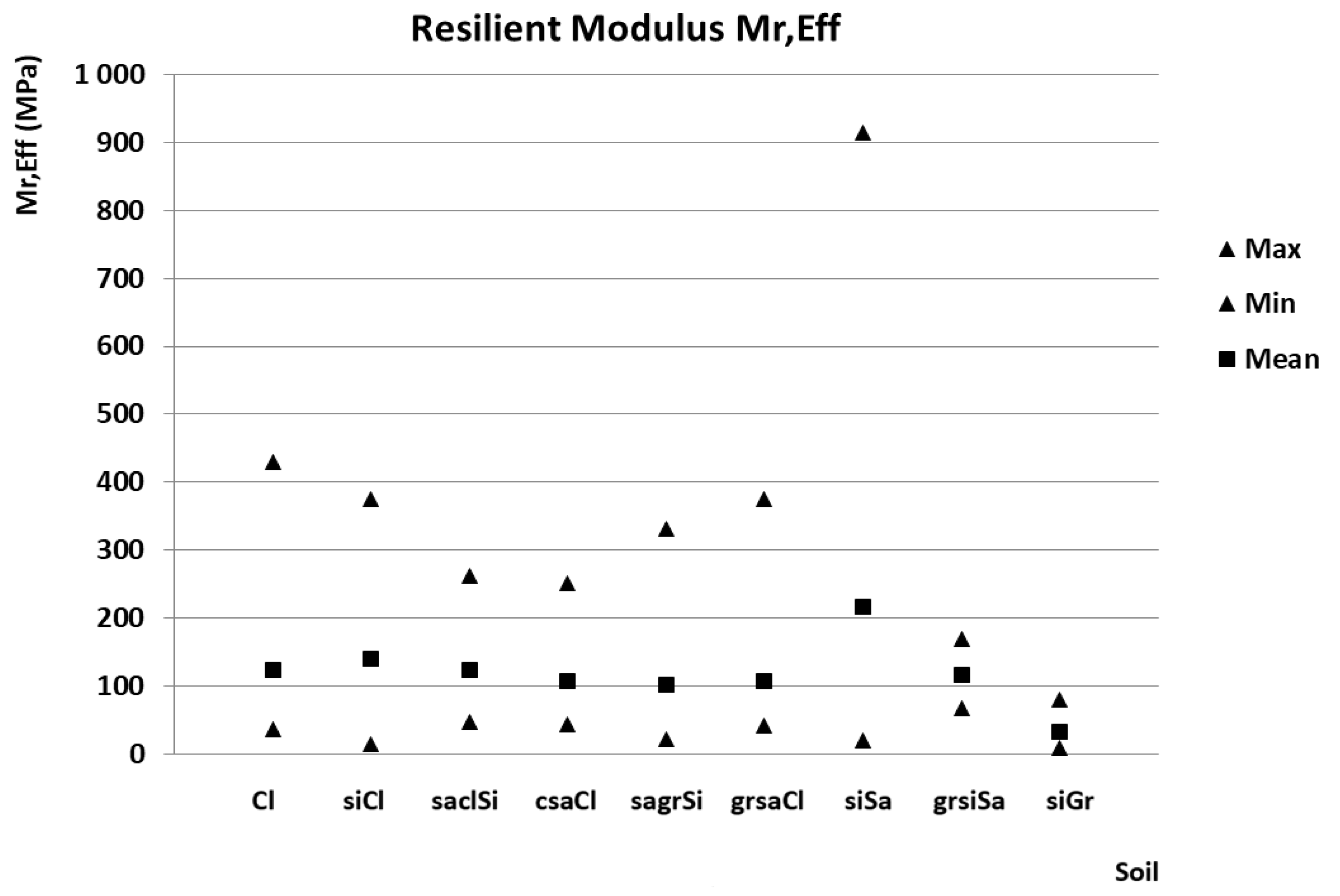
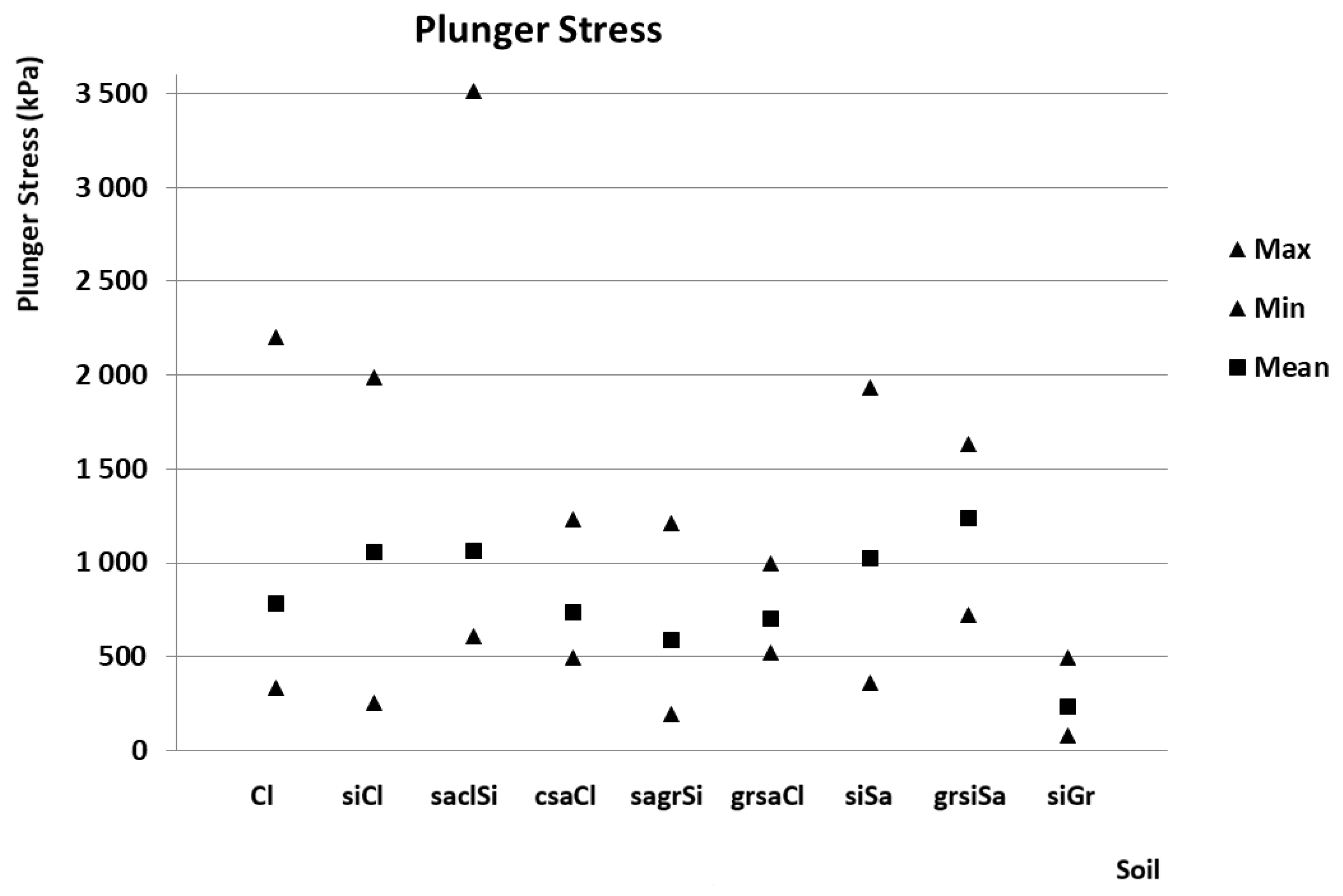
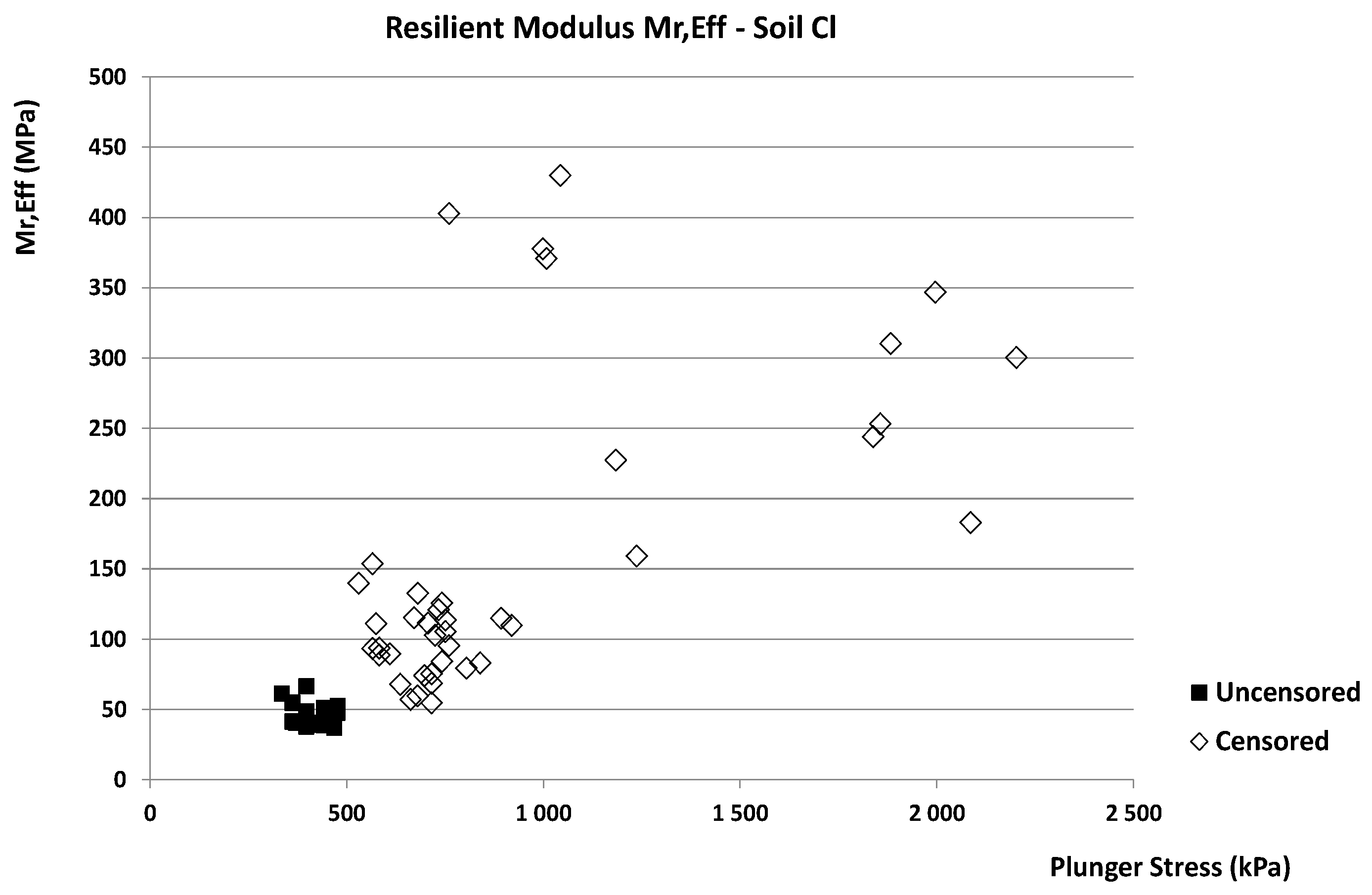
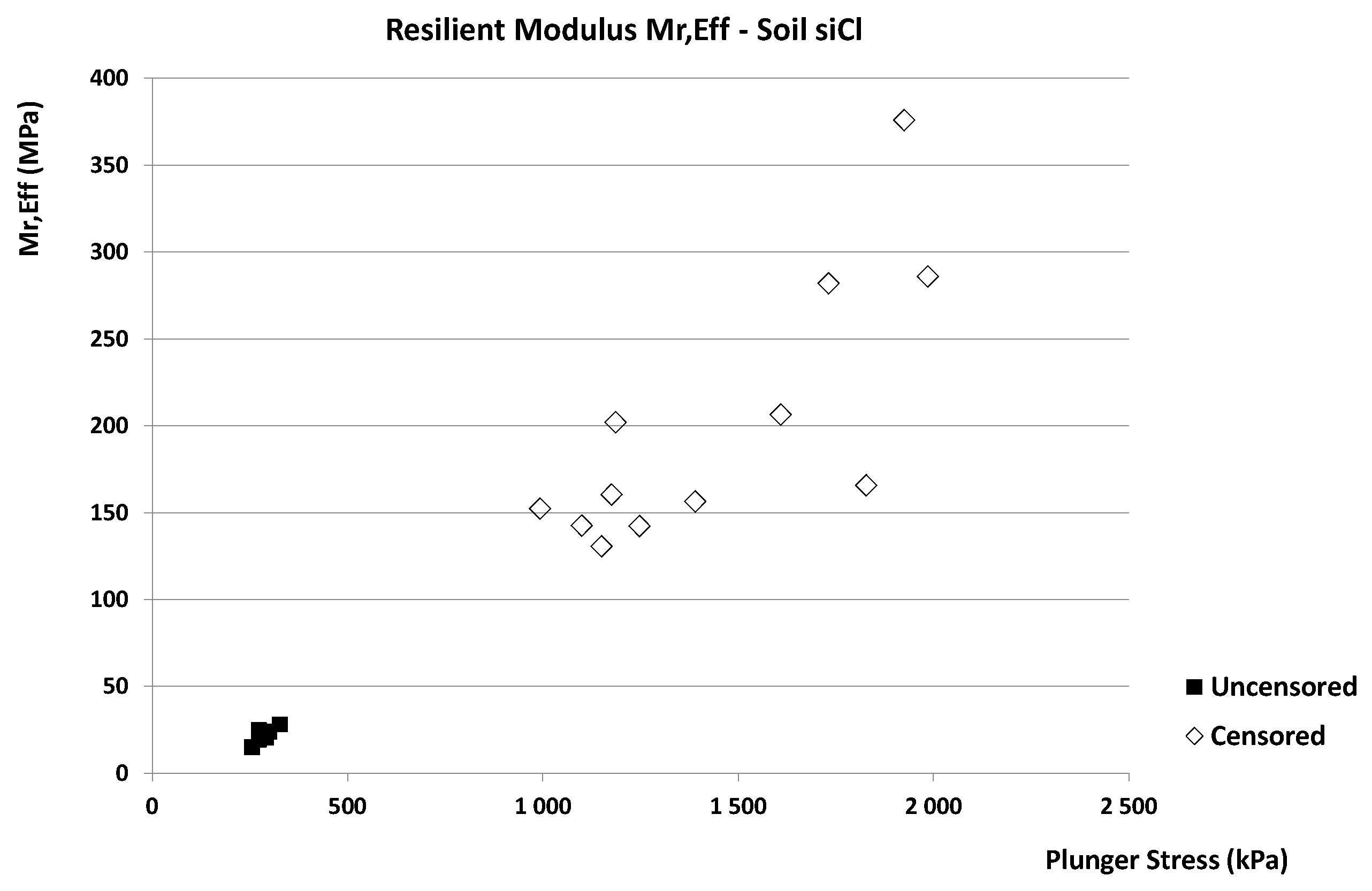
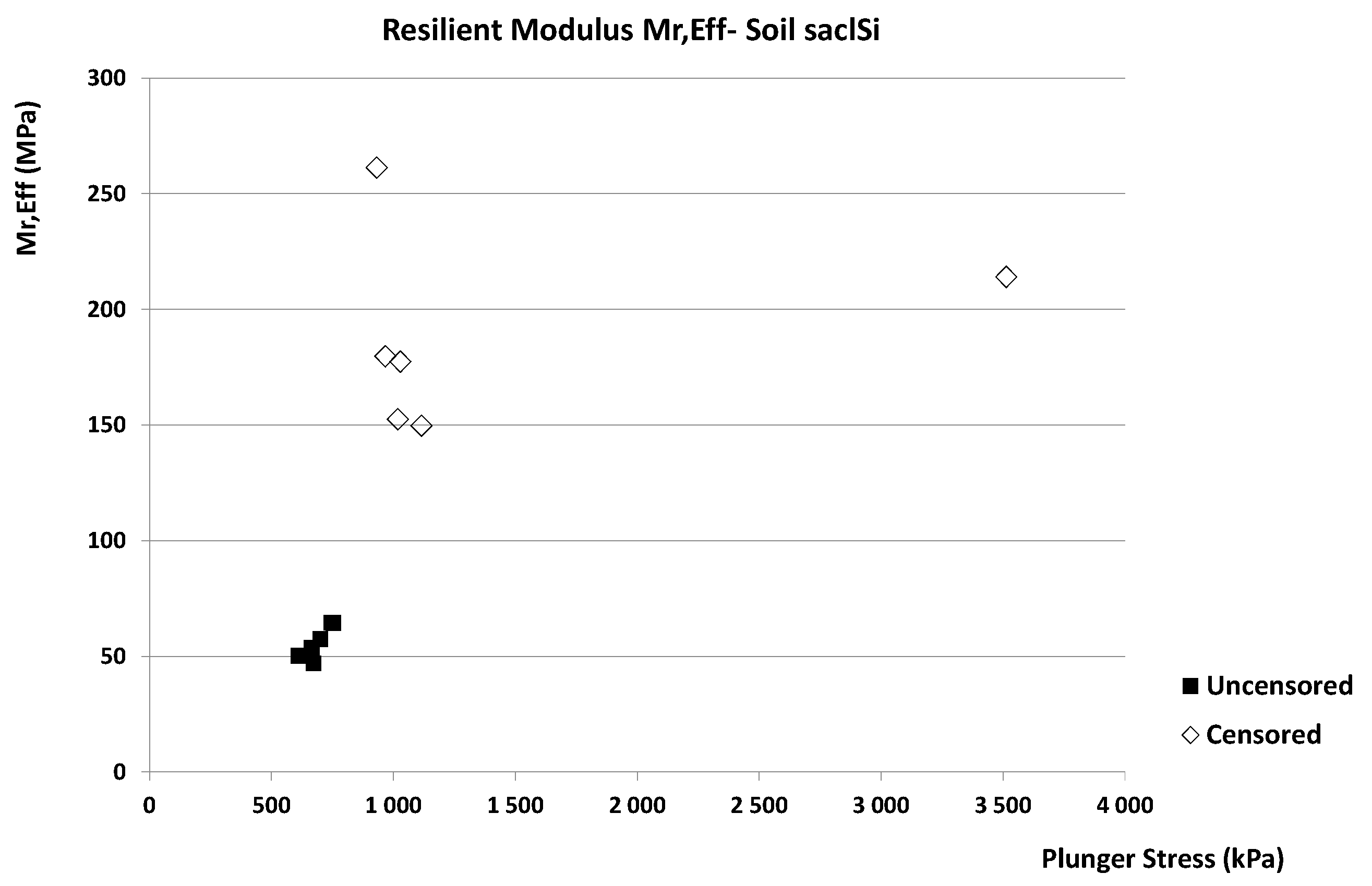
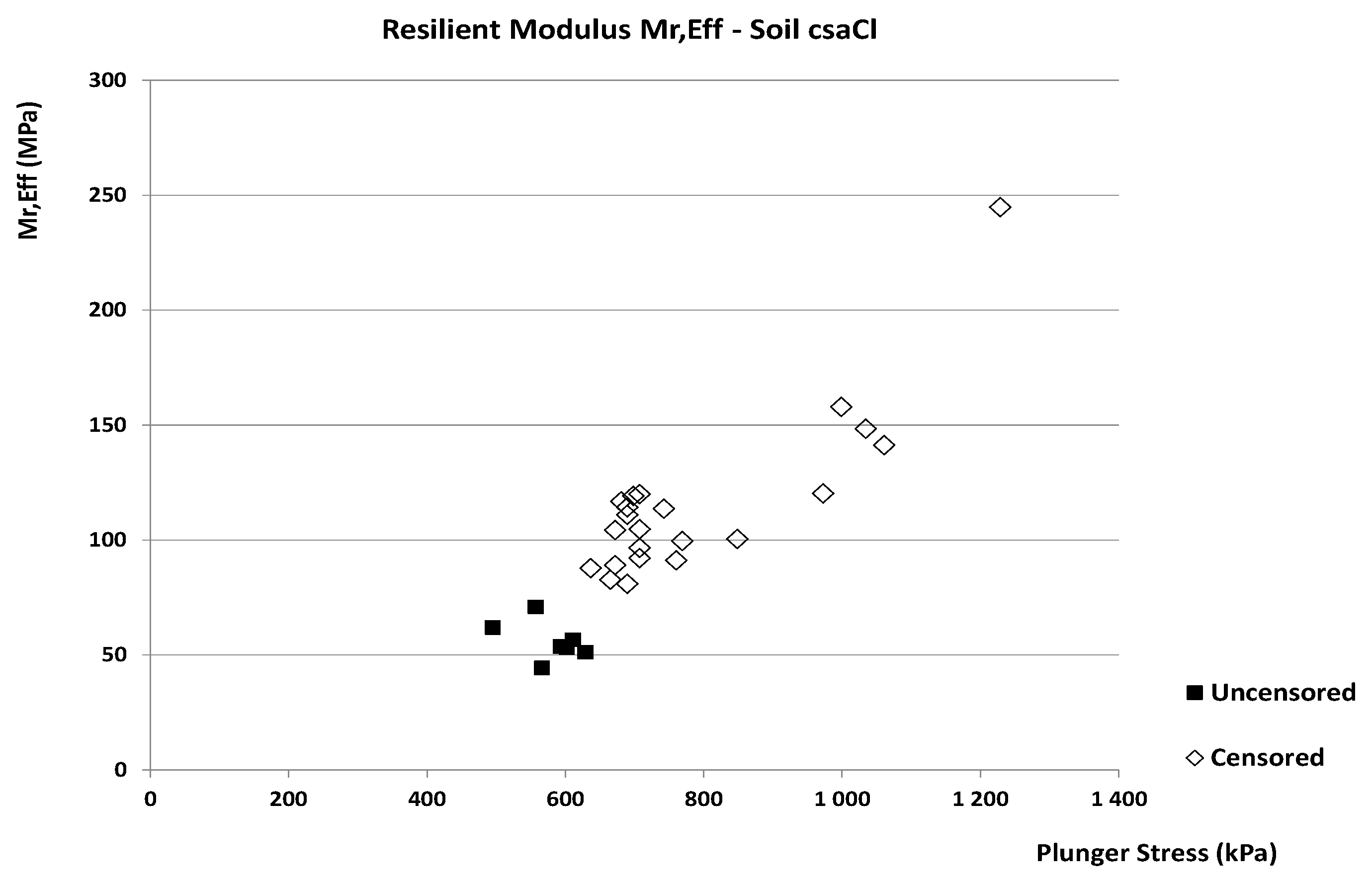
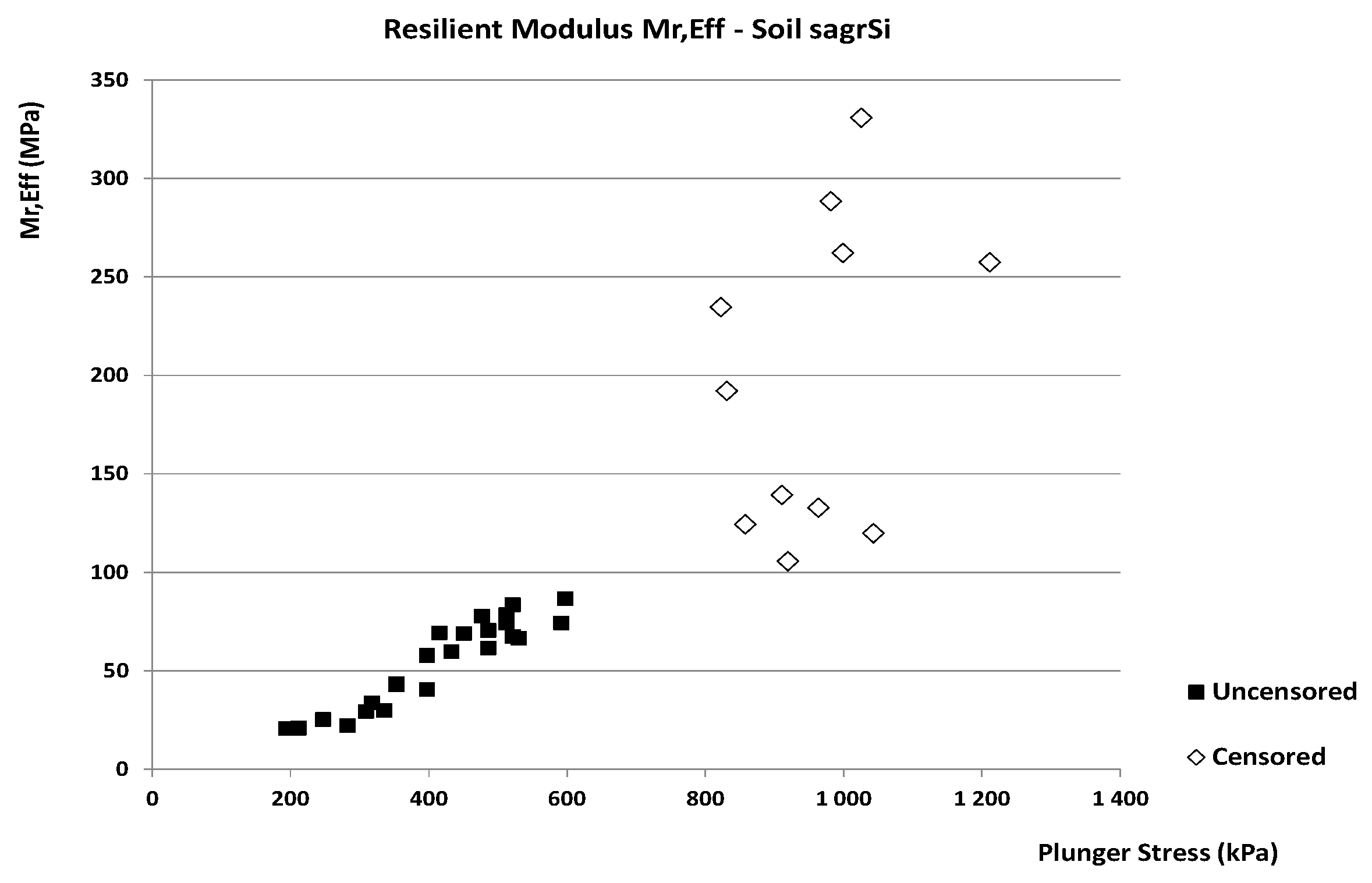
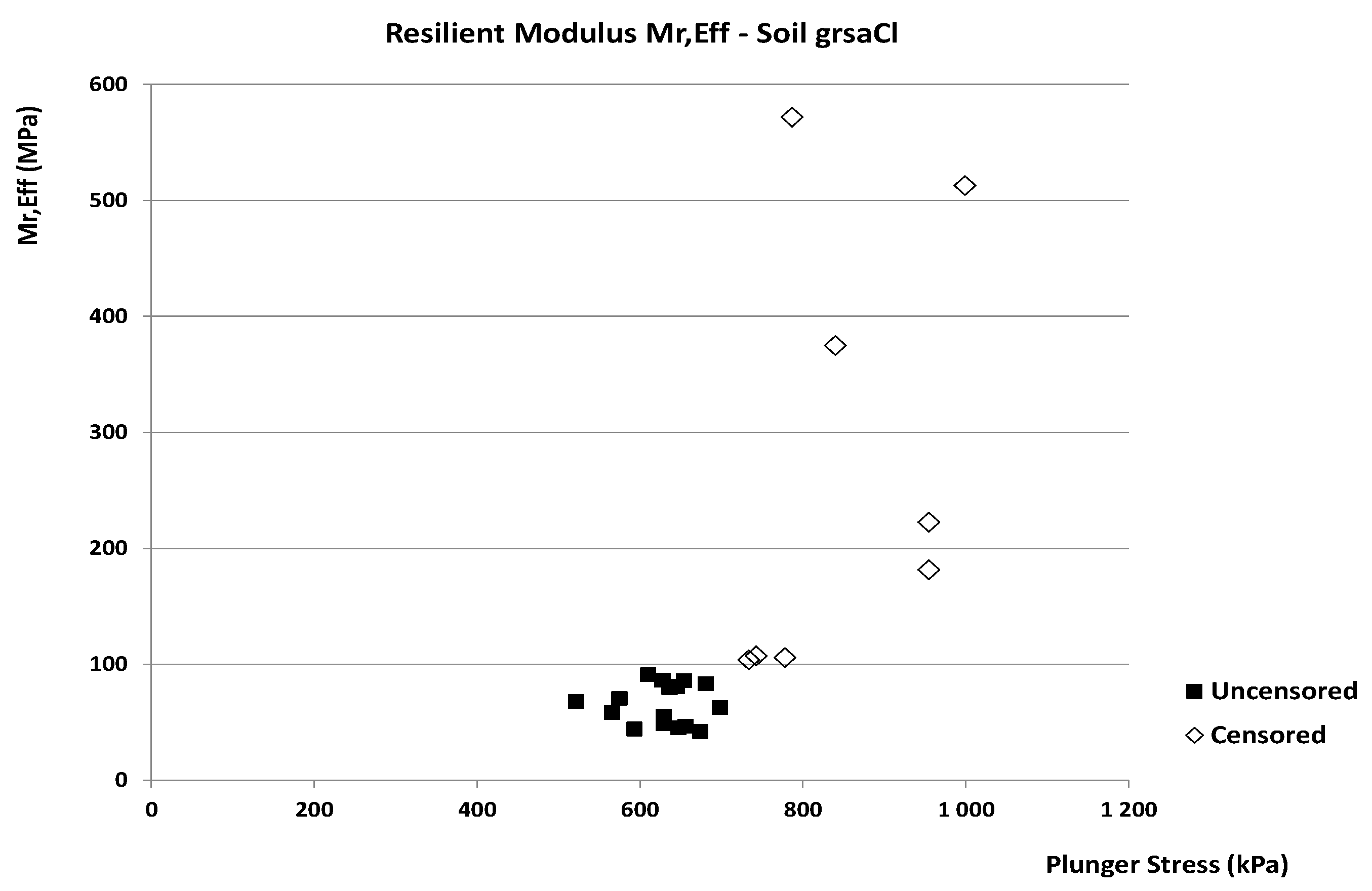

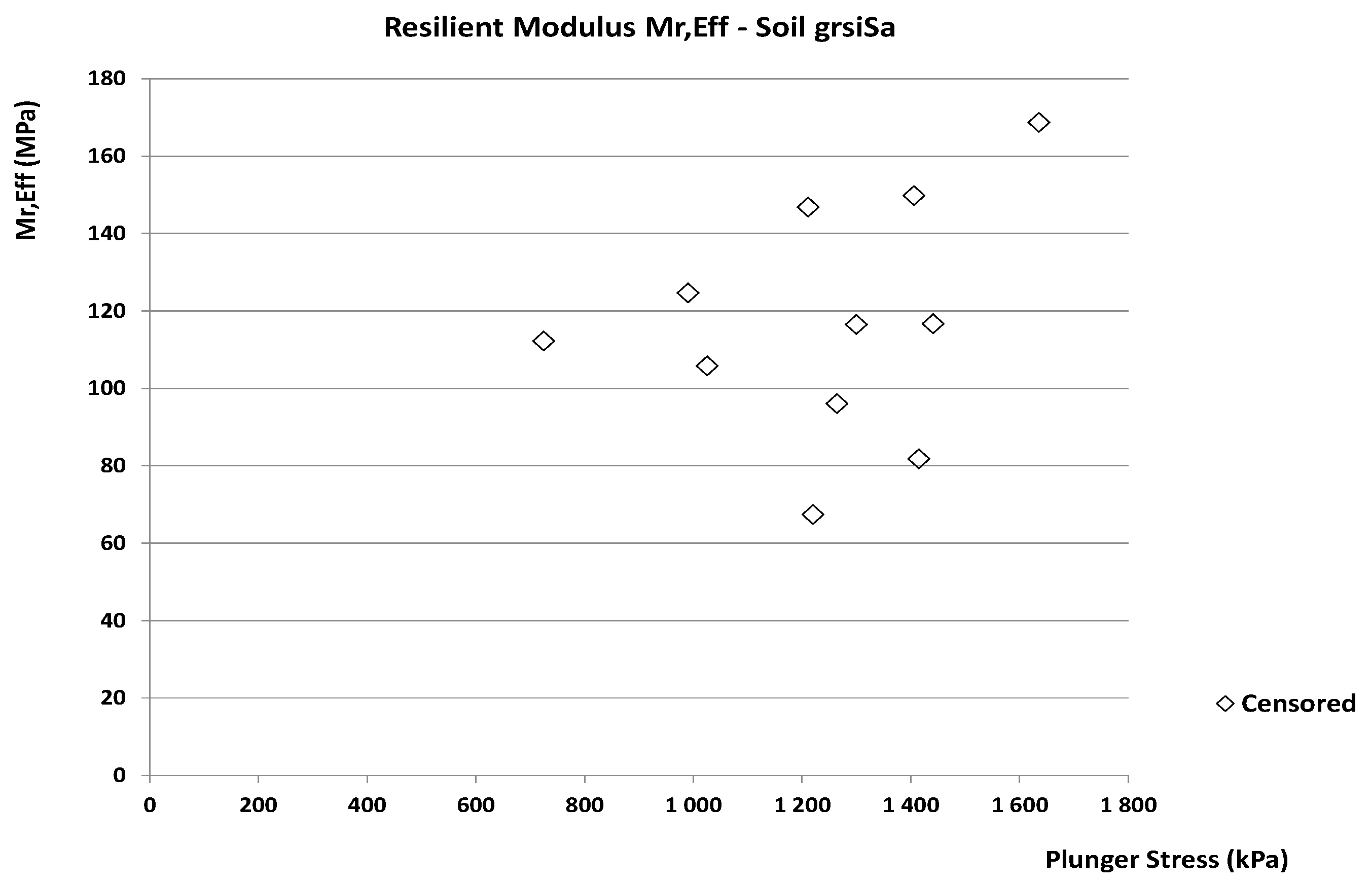
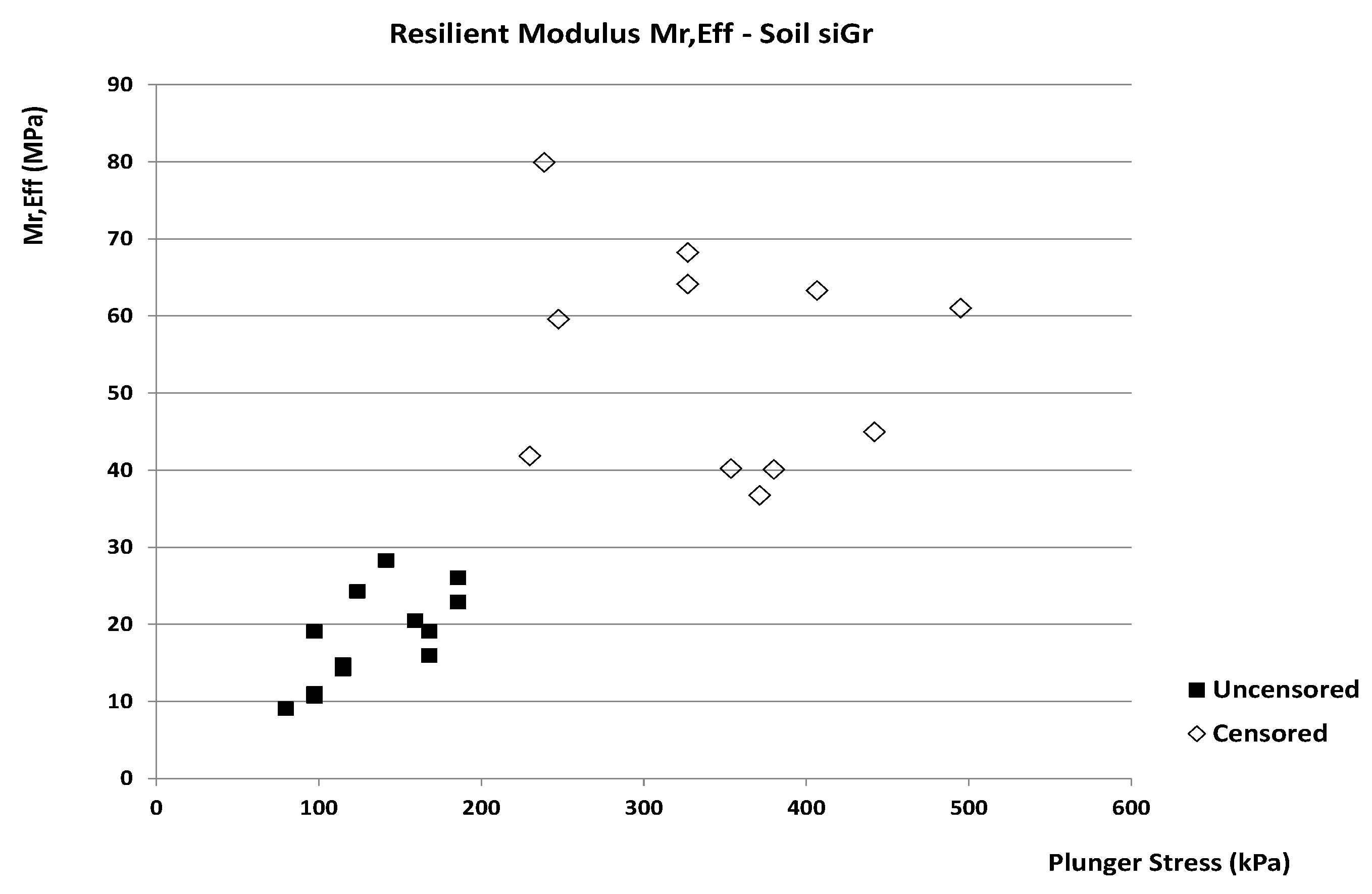
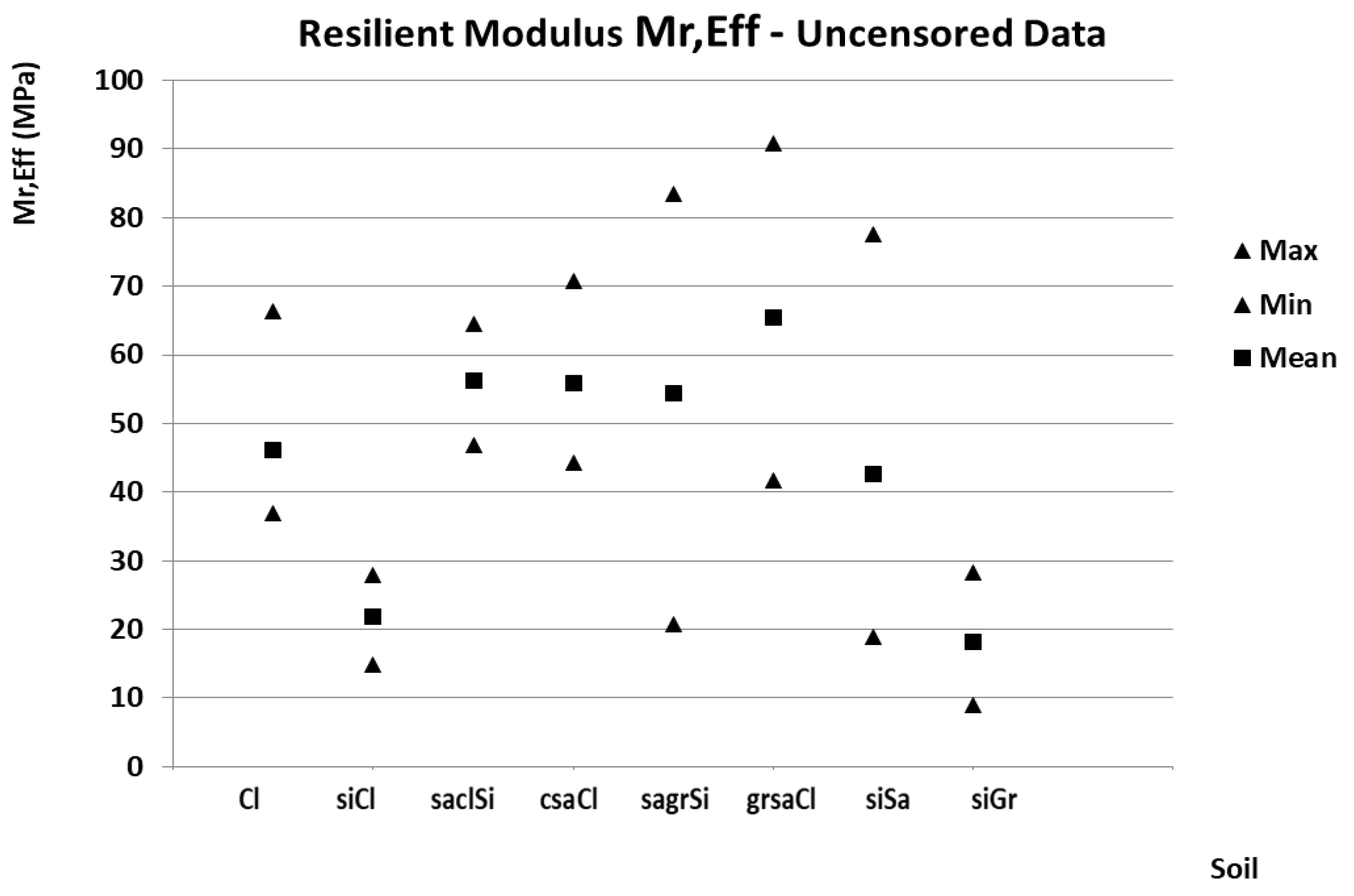
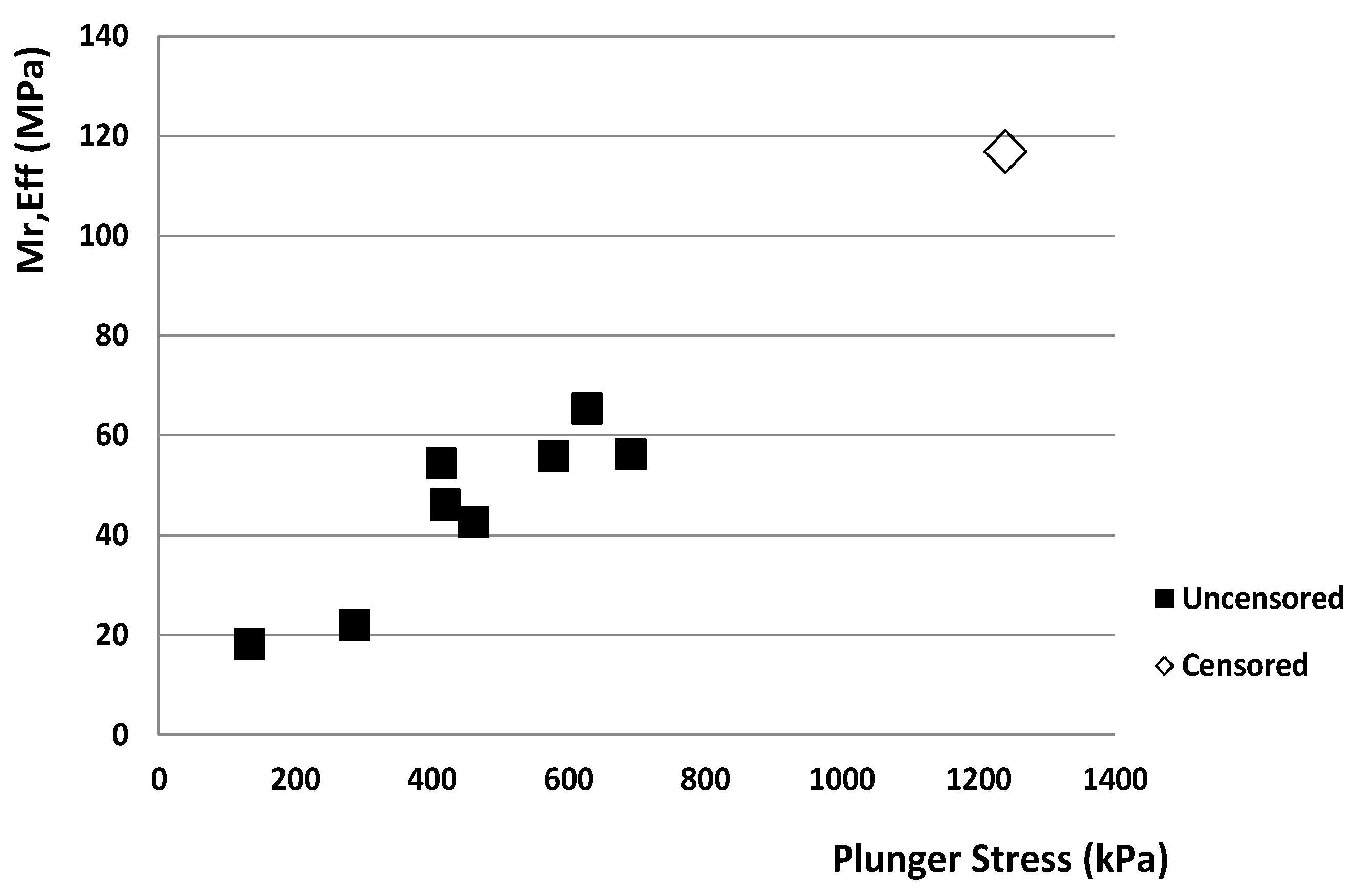
| Soil Type USCS | Sample Number | Specimen Number | Mean Density kg·m−3 | Mean Humidity % |
|---|---|---|---|---|
| Cl | 10 | 60 | 1598.8 | 23.8 |
| siCl | 3 | 18 | 1655.9 | 20.7 |
| saclSi | 2 | 12 | 1748.3 | 18.6 |
| csaCl | 5 | 30 | 1813.7 | 15.7 |
| sagrSi | 6 | 36 | 1858.5 | 13.4 |
| grsaCl | 4 | 24 | 1635.5 | 21.5 |
| siSa | 10 | 60 | 1796.0 | 14.7 |
| grsiSa | 2 | 12 | 1827.3 | 13.6 |
| siGr | 4 | 24 | 1929.6 | 12.7 |
| Soil Type | Mean | Min Mean | Max Mean MPa | Var | Min | Max |
|---|---|---|---|---|---|---|
| MPa | MPa | MPa | MPa | |||
| Cl | 123.3 | 43.2 | 327.9 | 0.83 | 36.9 | 429.9 |
| siCl | 140.8 | 21.9 | 226.5 | 1.08 | 14.9 | 375.9 |
| saclSi | 122.7 | 56.2 | 189.1 | 0.59 | 46.9 | 261.3 |
| csaCl | 106.9 | 51.8 | 177.2 | 0.46 | 44.2 | 250.8 |
| sagrSi | 101.8 | 28.5 | 260.9 | 0.78 | 20.8 | 330.7 |
| grsaCl | 107.9 | 46.9 | 272.4 | 0.82 | 41.8 | 374.9 |
| siSa | 216.5 | 25.7 | 675.7 | 0.98 | 19.0 | 913.6 |
| grsiSa | 116.9 | 116.8 | 117.1 | 0.24 | 67.4 | 168.7 |
| siGr | 32.2 | 13.8 | 45.0 | 0.60 | 9.0 | 79.9 |
| Soil Type | Mean | Var | Min | Max | Cor |
|---|---|---|---|---|---|
| kPa | kPa | kPa | |||
| Cl | 779.8 | 0.59 | 336.0 | 2202.8 | 0.83 |
| siCl | 1058.4 | 0.59 | 256.4 | 1986.3 | 0.93 |
| saclSi | 1060.7 | 0.75 | 611.2 | 3514.1 | 0.80 |
| csaCl | 737.8 | 0.23 | 495.1 | 1229.0 | 0.79 |
| sagrSi | 586.0 | 0.48 | 194.5 | 1211.3 | 0.93 |
| grsaCl | 701.5 | 0.18 | 521.7 | 999.1 | 0.66 |
| siSa | 1023.2 | 0.46 | 362.5 | 1935.3 | 0.94 |
| grsiSa | 1240.0 | 0.20 | 725.0 | 1635.7 | 0.25 |
| siGr | 231.4 | 0.54 | 79.6 | 495.1 | 0.86 |
| Soil Type | Mean | Var | Min | Max |
|---|---|---|---|---|
| MPa | MPa | MPa | ||
| Cl | 46.1 | 0.18 | 36.9 | 66.4 |
| siCl | 21.9 | 0.21 | 14.9 | 28.0 |
| saclSi | 56.2 | 0.13 | 46.9 | 64.5 |
| csaCl | 55.8 | 0.15 | 44.2 | 70.8 |
| sagrSi | 54.4 | 0.41 | 20.8 | 83.5 |
| grsaCl | 65.4 | 0.26 | 41.8 | 90.8 |
| siSa | 42.7 | 0.42 | 19.0 | 77.5 |
| grsiSa | - | - | - | - |
| siGr | 18.1 | 0.34 | 9.0 | 28.3 |
Publisher’s Note: MDPI stays neutral with regard to jurisdictional claims in published maps and institutional affiliations. |
© 2021 by the authors. Licensee MDPI, Basel, Switzerland. This article is an open access article distributed under the terms and conditions of the Creative Commons Attribution (CC BY) license (https://creativecommons.org/licenses/by/4.0/).
Share and Cite
Ševelová, L.; Florian, A.; Žák, J. Influence of Plunger Stress on Resilient Modulus of Forest Subgrade Soils Obtained from Cyclic CBR Test. Forests 2021, 12, 1456. https://doi.org/10.3390/f12111456
Ševelová L, Florian A, Žák J. Influence of Plunger Stress on Resilient Modulus of Forest Subgrade Soils Obtained from Cyclic CBR Test. Forests. 2021; 12(11):1456. https://doi.org/10.3390/f12111456
Chicago/Turabian StyleŠevelová, Lenka, Aleš Florian, and Jaroslav Žák. 2021. "Influence of Plunger Stress on Resilient Modulus of Forest Subgrade Soils Obtained from Cyclic CBR Test" Forests 12, no. 11: 1456. https://doi.org/10.3390/f12111456
APA StyleŠevelová, L., Florian, A., & Žák, J. (2021). Influence of Plunger Stress on Resilient Modulus of Forest Subgrade Soils Obtained from Cyclic CBR Test. Forests, 12(11), 1456. https://doi.org/10.3390/f12111456






